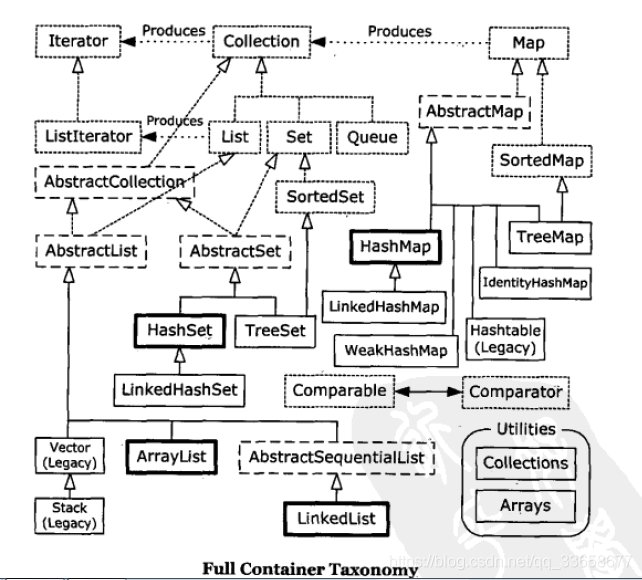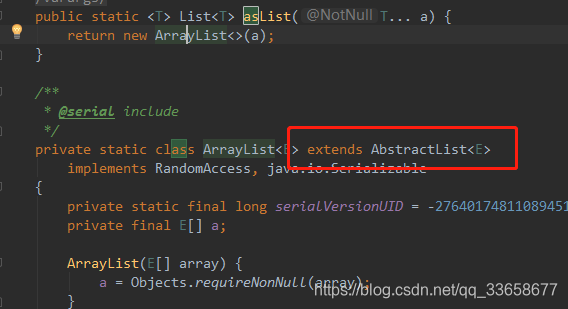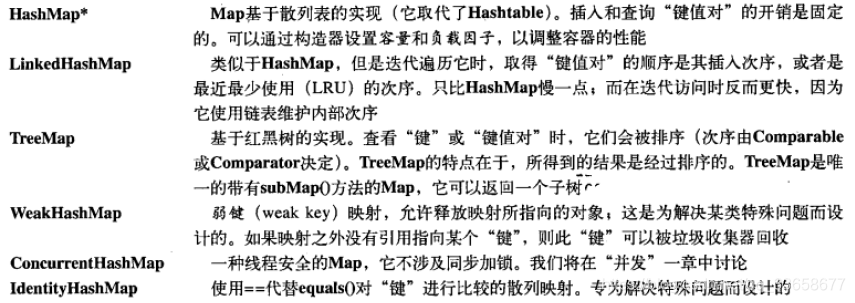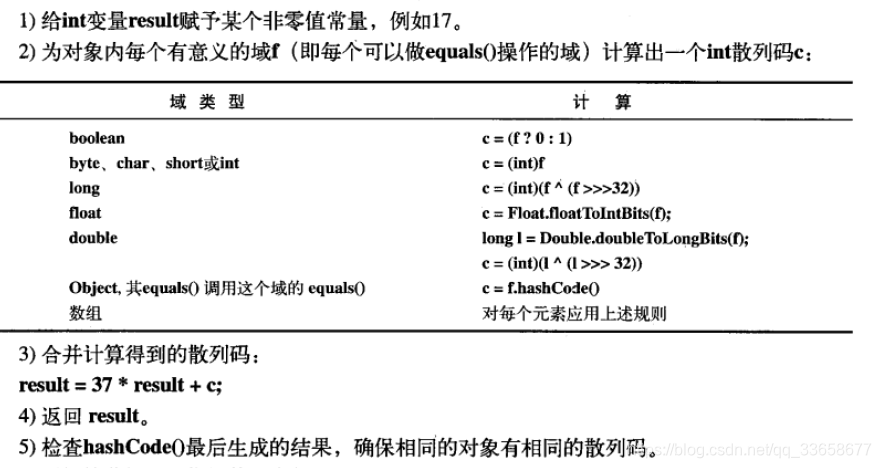目录
队列(除并发外,有链表LinkedList和优先级队列PriorityQueue)
一、首先简单了解下没有重写HashCode跟equals对传入散列容器的影响
本章主要记录如何使用即一些对比,并不做过多的详解。
类库简化图(虚线接口,实线类)

填充容器
1.使用generator, CollectionData<T>可以类似一个适配器,将Generator<T>适配到add()方法中。
public class CollectionData<T> extends ArrayList<T> {
public CollectionData(Generator<T> gen, int quantity) {
for(int i = 0; i < quantity; i++)
add(gen.next());
}
// A generic convenience method:
public static <T> CollectionData<T>
list(Generator<T> gen, int quantity) {
return new CollectionData<T>(gen, quantity);
}
} 2.Map生成器,这里看一下就知道了,不做详解,当工具来使用。
public class MapData<K,V> extends LinkedHashMap<K,V> {
// A single Pair Generator:
public MapData(Generator<Pair<K,V>> gen, int quantity) {
for(int i = 0; i < quantity; i++) {
Pair<K,V> p = gen.next();
put(p.key, p.value);
}
}
// Two separate Generators:
public MapData(Generator<K> genK, Generator<V> genV,
int quantity) {
for(int i = 0; i < quantity; i++) {
put(genK.next(), genV.next());
}
}
// A key Generator and a single value:
public MapData(Generator<K> genK, V value, int quantity){
for(int i = 0; i < quantity; i++) {
put(genK.next(), value);
}
}
// An Iterable and a value Generator:
public MapData(Iterable<K> genK, Generator<V> genV) {
for(K key : genK) {
put(key, genV.next());
}
}
// An Iterable and a single value:
public MapData(Iterable<K> genK, V value) {
for(K key : genK) {
put(key, value);
}
}
// Generic convenience methods:
public static <K,V> MapData<K,V>
map(Generator<Pair<K,V>> gen, int quantity) {
return new MapData<K,V>(gen, quantity);
}
public static <K,V> MapData<K,V>
map(Generator<K> genK, Generator<V> genV, int quantity) {
return new MapData<K,V>(genK, genV, quantity);
}
public static <K,V> MapData<K,V>
map(Generator<K> genK, V value, int quantity) {
return new MapData<K,V>(genK, value, quantity);
}
public static <K,V> MapData<K,V>
map(Iterable<K> genK, Generator<V> genV) {
return new MapData<K,V>(genK, genV);
}
public static <K,V> MapData<K,V>
map(Iterable<K> genK, V value) {
return new MapData<K,V>(genK, value);
}
}3.使用Abstract类,Entry是享元的设计模式。
private static class FlyweightMap
extends AbstractMap<String,String> {
private static class Entry
implements Map.Entry<String,String> {
int index;
Entry(int index) { this.index = index; }
public boolean equals(Object o) {
return DATA[index][0].equals(o);
}
public String getKey() { return DATA[index][0]; }
public String getValue() { return DATA[index][1]; }
public String setValue(String value) {
throw new UnsupportedOperationException();
}
public int hashCode() {
return DATA[index][0].hashCode();
}
}
// Use AbstractSet by implementing size() & iterator()
static class EntrySet
extends AbstractSet<Map.Entry<String,String>> {
private int size;
EntrySet(int size) {
if(size < 0)
this.size = 0;
// Can't be any bigger than the array:
else if(size > DATA.length)
this.size = DATA.length;
else
this.size = size;
}
public int size() { return size; }
private class Iter
implements Iterator<Map.Entry<String,String>> {
// Only one Entry object per Iterator:
private Entry entry = new Entry(-1);
public boolean hasNext() {
return entry.index < size - 1;
}
public Map.Entry<String,String> next() {
entry.index++;
return entry;
}
public void remove() {
throw new UnsupportedOperationException();
}
}
public
Iterator<Map.Entry<String,String>> iterator() {
return new Iter();
}
}
private static Set<Map.Entry<String,String>> entries =
new EntrySet(DATA.length);
public Set<Map.Entry<String,String>> entrySet() {
return entries;
}
}
// Create a partial map of 'size' countries:
static Map<String,String> select(final int size) {
return new FlyweightMap() {
public Set<Map.Entry<String,String>> entrySet() {
return new EntrySet(size);
}
};
}
static Map<String,String> map = new FlyweightMap();
public static Map<String,String> capitals() {
return map; // The entire map
}
public static Map<String,String> capitals(int size) {
return select(size); // A partial map
}
static List<String> names =
new ArrayList<String>(map.keySet());
// All the names:
public static List<String> names() { return names; }
// A partial list:
public static List<String> names(int size) {
return new ArrayList<String>(select(size).keySet());
}
可选操作(稍微了解一下)
我们知道Collection作为容器的顶层接口,那么如List,Set,Queue都是描述不同容器的并继承Colleciton,好,假设当你需要做一个属于自己的容器,那么你需要去实现接口,这个容器你并不想支持add()操作,那么可选操作就执行你通过throw UnspportedOperationException,表示不支持的操作,也就并不需要你去真正实现这个add()的方法,也防止了“接口爆炸”。

例如Array.asList返回的是一个继承AbstractList, ,这个返回的一个固定尺寸的List,所以这里的add是不允许的,通过 throw new UnsupportedOperationException();来完成可选操作!
,这个返回的一个固定尺寸的List,所以这里的add是不允许的,通过 throw new UnsupportedOperationException();来完成可选操作!
List(这里比较简单就跳过)
Set和存储顺序
Set必须定义equals方法确定对象唯一性,而HashSet(速度优化),LinkedHashSet(根据插入顺序)上面这两种都必须实现HashCode,TreeSet是有序Set,通过必须实现Comparable接口完成排序的规则。如果不按要求就会报错。
class SetType {
int i;
public SetType(int n) { i = n; }
public boolean equals(Object o) {
return o instanceof SetType && (i == ((SetType)o).i);
}
public String toString() { return Integer.toString(i); }
}
class HashType extends SetType {
public HashType(int n) { super(n); }
public int hashCode() { return i; }
}
class TreeType extends SetType
implements Comparable<TreeType> {
public TreeType(int n) { super(n); }
public int compareTo(TreeType arg) {
return (arg.i < i ? -1 : (arg.i == i ? 0 : 1));
}
}
public class TypesForSets {
static <T> Set<T> fill(Set<T> set, Class<T> type) {
try {
for(int i = 0; i < 10; i++)
set.add(
type.getConstructor(int.class).newInstance(i));
} catch(Exception e) {
throw new RuntimeException(e);
}
return set;
}
static <T> void test(Set<T> set, Class<T> type) {
fill(set, type);
fill(set, type); // Try to add duplicates
fill(set, type);
System.out.println(set);
}
public static void main(String[] args) {
test(new HashSet<HashType>(), HashType.class);
test(new LinkedHashSet<HashType>(), HashType.class);
test(new TreeSet<TreeType>(), TreeType.class);
// Things that don't work:
test(new HashSet<SetType>(), SetType.class);
test(new HashSet<TreeType>(), TreeType.class);
test(new LinkedHashSet<SetType>(), SetType.class);
test(new LinkedHashSet<TreeType>(), TreeType.class);
try {
test(new TreeSet<SetType>(), SetType.class);
} catch(Exception e) {
System.out.println(e.getMessage());
}
try {
test(new TreeSet<HashType>(), HashType.class);
} catch(Exception e) {
System.out.println(e.getMessage());
}
}
} /* Output: (Sample)
[2, 4, 9, 8, 6, 1, 3, 7, 5, 0]
[0, 1, 2, 3, 4, 5, 6, 7, 8, 9]
[9, 8, 7, 6, 5, 4, 3, 2, 1, 0]
[9, 9, 7, 5, 1, 2, 6, 3, 0, 7, 2, 4, 4, 7, 9, 1, 3, 6, 2, 4, 3, 0, 5, 0, 8, 8, 8, 6, 5, 1]
[0, 5, 5, 6, 5, 0, 3, 1, 9, 8, 4, 2, 3, 9, 7, 3, 4, 4, 0, 7, 1, 9, 6, 2, 1, 8, 2, 8, 6, 7]
[0, 1, 2, 3, 4, 5, 6, 7, 8, 9, 0, 1, 2, 3, 4, 5, 6, 7, 8, 9, 0, 1, 2, 3, 4, 5, 6, 7, 8, 9]
[0, 1, 2, 3, 4, 5, 6, 7, 8, 9, 0, 1, 2, 3, 4, 5, 6, 7, 8, 9, 0, 1, 2, 3, 4, 5, 6, 7, 8, 9]
java.lang.ClassCastException: SetType cannot be cast to java.lang.Comparable
java.lang.ClassCastException: HashType cannot be cast to java.lang.Comparable
*///:~队列(除并发外,有链表LinkedList和优先级队列PriorityQueue)
这里主要放上一个PriorityQueue的例子
class ToDoList extends PriorityQueue<ToDoList.ToDoItem> {
static class ToDoItem implements Comparable<ToDoItem> {
private char primary;
private int secondary;
private String item;
public ToDoItem(String td, char pri, int sec) {
primary = pri;
secondary = sec;
item = td;
}
public int compareTo(ToDoItem arg) {
if(primary > arg.primary)
return +1;
if(primary == arg.primary)
if(secondary > arg.secondary)
return +1;
else if(secondary == arg.secondary)
return 0;
return -1;
}
public String toString() {
return Character.toString(primary) +
secondary + ": " + item;
}
}
public void add(String td, char pri, int sec) {
super.add(new ToDoItem(td, pri, sec));
}
public static void main(String[] args) {
ToDoList toDoList = new ToDoList();
toDoList.add("Empty trash", 'C', 4);
toDoList.add("Feed dog", 'A', 2);
toDoList.add("Feed bird", 'B', 7);
toDoList.add("Mow lawn", 'C', 3);
toDoList.add("Water lawn", 'A', 1);
toDoList.add("Feed cat", 'B', 1);
while(!toDoList.isEmpty())
System.out.println(toDoList.remove());
}
} /* Output:
A1: Water lawn
A2: Feed dog
B1: Feed cat
B7: Feed bird
C3: Mow lawn
C4: Empty trash
*///:~和一个双向队列的实现(也就是可以从两段抽取数据)
public class Deque<T> {
private LinkedList<T> deque = new LinkedList<T>();
public void addFirst(T e) { deque.addFirst(e); }
public void addLast(T e) { deque.addLast(e); }
public T getFirst() { return deque.getFirst(); }
public T getLast() { return deque.getLast(); }
public T removeFirst() { return deque.removeFirst(); }
public T removeLast() { return deque.removeLast(); }
public int size() { return deque.size(); }
public String toString() { return deque.toString(); }
// And other methods as necessary...
}理解Map(这里的区别与List差不多就不做说明了)

散列与散列码(这里需要掌握)
相信看到这里,对于HashSet,HashMap使用自定义的类作为键都需要重写HashCode以及equals方法都知道吧,下面我就深究一下为什么。
一、首先简单了解下没有重写HashCode跟equals对传入散列容器的影响
public class Groundhog {
protected int number;
public Groundhog(int n) { number = n; }
public String toString() {
return "Groundhog #" + number;
}
} ///:~
public class Groundhog2 extends Groundhog {
public Groundhog2(int n) { super(n); }
public int hashCode() { return number; }
public boolean equals(Object o) {
return o instanceof Groundhog2 &&
(number == ((Groundhog2)o).number);
}
}
public class Prediction {
private static Random rand = new Random(47);
private boolean shadow = rand.nextDouble() > 0.5;
public String toString() {
if(shadow)
return "Six more weeks of Winter!";
else
return "Early Spring!";
}
}
public class SpringDetector {
// Uses a Groundhog or class derived from Groundhog:
public static <T extends Groundhog>
void detectSpring(Class<T> type) throws Exception {
Constructor<T> ghog = type.getConstructor(int.class);
Map<Groundhog,Prediction> map =
new HashMap<Groundhog,Prediction>();
for(int i = 0; i < 10; i++)
map.put(ghog.newInstance(i), new Prediction());
print("map = " + map);
Groundhog gh = ghog.newInstance(3);
print("Looking up prediction for " + gh);
if(map.containsKey(gh))
print(map.get(gh));
else
print("Key not found: " + gh);
}
public static void main(String[] args) throws Exception {
detectSpring(Groundhog.class);
detectSpring(Groundhog2.class);
}
} /* Output:
map = {Groundhog #3=Early Spring!, Groundhog #7=Early Spring!, Groundhog #5=Early Spring!, Groundhog #9=Six more weeks of Winter!, Groundhog #8=Six more weeks of Winter!, Groundhog #0=Six more weeks of Winter!, Groundhog #6=Early Spring!, Groundhog #4=Six more weeks of Winter!, Groundhog #1=Six more weeks of Winter!, Groundhog #2=Early Spring!}
Looking up prediction for Groundhog #3
Key not found: Groundhog #3
map = {Groundhog #2=Early Spring!, Groundhog #4=Six more weeks of Winter!, Groundhog #9=Six more weeks of Winter!, Groundhog #8=Six more weeks of Winter!, Groundhog #6=Early Spring!, Groundhog #1=Six more weeks of Winter!, Groundhog #3=Early Spring!, Groundhog #7=Early Spring!, Groundhog #5=Early Spring!, Groundhog #0=Six more weeks of Winter!}
Looking up prediction for Groundhog #3
Early Spring!
*///:~
这里SpringDetector中,我们可以看到当传入Groundhog类,而这个类并没有重写HashCode跟equals方法,当进行map.containsKey(gh)时,因为Groundhog gh = ghog.newInstance(3)这里生成的第二个实例,调用的是Object的HashCode方法(默认是根据对象地址计算)跟equals方法(比较对象地址),那么很明显两个实例的地址不一样,所以在对比时,虽然内容一样,实际上程序判断是不一样的。所以这个时候我们在Groundhog2类中重写了HashCode和equlas方法才能正常执行。
二、什么是散列码跟散列
1.为什么要重写HashCode散列码
我们知道数组是保存数据最快的数据结构,那么我们用数组来存储键信息,而数组又是固定长度,这个时候我们就需要把数组分成一个一个槽,把键值对放到这一个一个槽中,而每个槽位(slot也叫做桶位bucket)有下标,这个下标就是散列码,那么怎么把键值对平均分到每个槽中,这个就需要使用HashCode也就是散列码进行分类。
按照上面这样,那么我根据散列码找到对应的槽,也就省去了线性查询的弊端,我可以根据散列码找到你属于哪个槽,我直接在槽里查找,是不是省去查询其他槽里的数据了,所以速度上就有了很大的提升。
2.为什么要重写equals方法
上面说到每个槽里面是存在多组数据的,那么这个槽中使用一个List装载这些数据,而在对这个List数据进行一一equals的时候,当然,这个时候就是线性查询了,这个时候就比较慢了,但是我们如果能将每个槽的数据都平分,那么仅仅只是在一小组数据中查询,这样速度就提升很多。
这里对上面两点的说法通过代码实现
public class SimpleHashMap<K,V> extends AbstractMap<K,V> {
// Choose a prime number for the hash table
// size, to achieve a uniform distribution:
static final int SIZE = 997;
// You can't have a physical array of generics,
// but you can upcast to one:
@SuppressWarnings("unchecked")
LinkedList<MapEntry<K,V>>[] buckets =
new LinkedList[SIZE];
public V put(K key, V value) {
V oldValue = null;
int index = Math.abs(key.hashCode()) % SIZE;
if(buckets[index] == null)
buckets[index] = new LinkedList<MapEntry<K,V>>();
LinkedList<MapEntry<K,V>> bucket = buckets[index];
MapEntry<K,V> pair = new MapEntry<K,V>(key, value);
boolean found = false;
ListIterator<MapEntry<K,V>> it = bucket.listIterator();
while(it.hasNext()) {
MapEntry<K,V> iPair = it.next();
if(iPair.getKey().equals(key)) {
oldValue = iPair.getValue();
it.set(pair); // Replace old with new
found = true;
break;
}
}
if(!found)
buckets[index].add(pair);
return oldValue;
}
public V get(Object key) {
int index = Math.abs(key.hashCode()) % SIZE;
if(buckets[index] == null) return null;
for(MapEntry<K,V> iPair : buckets[index])
if(iPair.getKey().equals(key))
return iPair.getValue();
return null;
}
public Set<Map.Entry<K,V>> entrySet() {
Set<Map.Entry<K,V>> set= new HashSet<Map.Entry<K,V>>();
for(LinkedList<MapEntry<K,V>> bucket : buckets) {
if(bucket == null) continue;
for(MapEntry<K,V> mpair : bucket)
set.add(mpair);
}
return set;
}
public static void main(String[] args) {
SimpleHashMap<String,String> m =
new SimpleHashMap<String,String>();
m.putAll(Countries.capitals(25));
System.out.println(m);
System.out.println(m.get("ERITREA"));
System.out.println(m.entrySet());
}
} /* Output:
{CAMEROON=Yaounde, CONGO=Brazzaville, CHAD=N'djamena, COTE D'IVOIR (IVORY COAST)=Yamoussoukro, CENTRAL AFRICAN REPUBLIC=Bangui, GUINEA=Conakry, BOTSWANA=Gaberone, BISSAU=Bissau, EGYPT=Cairo, ANGOLA=Luanda, BURKINA FASO=Ouagadougou, ERITREA=Asmara, THE GAMBIA=Banjul, KENYA=Nairobi, GABON=Libreville, CAPE VERDE=Praia, ALGERIA=Algiers, COMOROS=Moroni, EQUATORIAL GUINEA=Malabo, BURUNDI=Bujumbura, BENIN=Porto-Novo, BULGARIA=Sofia, GHANA=Accra, DJIBOUTI=Dijibouti, ETHIOPIA=Addis Ababa}
Asmara
[CAMEROON=Yaounde, CONGO=Brazzaville, CHAD=N'djamena, COTE D'IVOIR (IVORY COAST)=Yamoussoukro, CENTRAL AFRICAN REPUBLIC=Bangui, GUINEA=Conakry, BOTSWANA=Gaberone, BISSAU=Bissau, EGYPT=Cairo, ANGOLA=Luanda, BURKINA FASO=Ouagadougou, ERITREA=Asmara, THE GAMBIA=Banjul, KENYA=Nairobi, GABON=Libreville, CAPE VERDE=Praia, ALGERIA=Algiers, COMOROS=Moroni, EQUATORIAL GUINEA=Malabo, BURUNDI=Bujumbura, BENIN=Porto-Novo, BULGARIA=Sofia, GHANA=Accra, DJIBOUTI=Dijibouti, ETHIOPIA=Addis Ababa]
*///:~那么对于散列码的编写就很重要了,这是你分数据到槽里的依据,编写一个好的散列码就很重要了。
书中给出一些基本指导:

这里给个按照上面的指导的例子
public class CountedString {
private static List<String> created =
new ArrayList<String>();
private String s;
private int id = 0;
public CountedString(String str) {
s = str;
created.add(s);
// id is the total number of instances
// of this string in use by CountedString:
for(String s2 : created)
if(s2.equals(s))
id++;
}
public String toString() {
return "String: " + s + " id: " + id +
" hashCode(): " + hashCode();
}
public int hashCode() {
// The very simple approach:
// return s.hashCode() * id;
// Using Joshua Bloch's recipe:
int result = 17;
result = 37 * result + s.hashCode();
result = 37 * result + id;
return result;
}
public boolean equals(Object o) {
return o instanceof CountedString &&
s.equals(((CountedString)o).s) &&
id == ((CountedString)o).id;
}
public static void main(String[] args) {
Map<CountedString,Integer> map =
new HashMap<CountedString,Integer>();
CountedString[] cs = new CountedString[5];
for(int i = 0; i < cs.length; i++) {
cs[i] = new CountedString("hi");
map.put(cs[i], i); // Autobox int -> Integer
}
print(map);
for(CountedString cstring : cs) {
print("Looking up " + cstring);
print(map.get(cstring));
}
}
} /* Output: (Sample)
{String: hi id: 4 hashCode(): 146450=3, String: hi id: 1 hashCode(): 146447=0, String: hi id: 3 hashCode(): 146449=2, String: hi id: 5 hashCode(): 146451=4, String: hi id: 2 hashCode(): 146448=1}
Looking up String: hi id: 1 hashCode(): 146447
0
Looking up String: hi id: 2 hashCode(): 146448
1
Looking up String: hi id: 3 hashCode(): 146449
2
Looking up String: hi id: 4 hashCode(): 146450
3
Looking up String: hi id: 5 hashCode(): 146451
4
*///:~持有引用

大概意思就是,通过Refernce类来包装你的数据,通过Refernce知道你这个数据是“可获得的”,也就是你这条数据在被直接或者间接的使用,那么垃圾回收机制就不会清理,否则就会清理掉,而三种都是各个各的特性。

WeakHashMap
这是Map的一种,可以节约空间,允许垃圾回收机制回收其中的时候,而触发条件是,不再需要这个键。
class Element {
private String ident;
public Element(String id) { ident = id; }
public String toString() { return ident; }
public int hashCode() { return ident.hashCode(); }
public boolean equals(Object r) {
return r instanceof Element &&
ident.equals(((Element)r).ident);
}
protected void finalize() {
System.out.println("Finalizing " +
getClass().getSimpleName() + " " + ident);
}
}
class Key extends Element {
public Key(String id) { super(id); }
}
class Value extends Element {
public Value(String id) { super(id); }
}
public class CanonicalMapping {
public static void main(String[] args) {
int size = 1000;
// Or, choose size via the command line:
if(args.length > 0)
size = new Integer(args[0]);
Key[] keys = new Key[size];
WeakHashMap<Key,Value> map =
new WeakHashMap<Key,Value>();
for(int i = 0; i < size; i++) {
Key k = new Key(Integer.toString(i));
Value v = new Value(Integer.toString(i));
if(i % 3 == 0)
keys[i] = k; // Save as "real" references
map.put(k, v);
}
System.gc();
}
}
/*最后会通过System.gc();释放没有使用的数据,下面是释放的信息很多
,这里只放一部分,因为当取模为0时,数组持有这些数据,而不为0时没有使用到,所以都释放掉了
Finalizing Key 385
Finalizing Key 910
Finalizing Key 988
Finalizing Key 16
Finalizing Key 73
Finalizing Key 71
Finalizing Key 70
Finalizing Key 68
。。。。*/总结
本章主要是对容器的一些方法的深入探究,所以当做工具来看不错的,其中比较重要需要我们记住的就是:
一、散列容器的散列和散列码
二、可选操作
三、各容器的长处短处,并针对场景选择
四、各容器的实现原理和一些方法的使用
五、一些不常用但是需要我们知道的东西








 本文深入探讨Java集合框架,包括类库简化图、填充容器、可选操作、List、Set、队列、Map的使用及原理,重点讲解散列与散列码的重要性,以及WeakHashMap的特性。
本文深入探讨Java集合框架,包括类库简化图、填充容器、可选操作、List、Set、队列、Map的使用及原理,重点讲解散列与散列码的重要性,以及WeakHashMap的特性。

















 被折叠的 条评论
为什么被折叠?
被折叠的 条评论
为什么被折叠?








